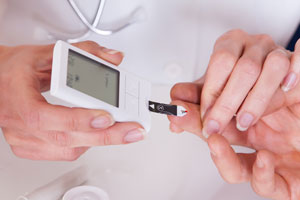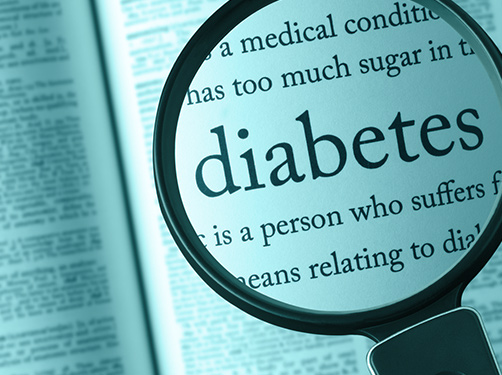How is type 2 diabetes diagnosed?
Scientific support: Dr. Oana Patricia Zaharia
Type 2 diabetes typically develops gradually over several years, often without symptoms. Therefore, the diagnosis is often made by chance during a health check-up or due to diabetes-related secondary diseases.
Various parameters are used for the diagnosis of type 2 diabetes: In addition to determining the long-term blood sugar level (HbA1c), fasting blood sugar, or random blood sugar, an oral glucose tolerance test (OGTT) can also be conducted.
In the following, we present the different diagnostic criteria and provide tips and guidance for the time after the diagnosis.

Type 2 diabetes does not develop overnight. Over several years, the metabolic disorder develops, with body cells becoming less sensitive to the hormone insulin (insulin resistance). Insulin is needed to take up sugar (glucose) from food into the body cells and use it as an energy source. Over time, insulin production in the pancreas also decreases. This leads to higher blood sugar levels, which can be harmful to health in the long run.
More information on the development of type 2 diabetes and possible causes can be found here.
Due to its gradual development, type 2 diabetes initially often progresses asymptomatically or with nonspecific symptoms that are often misinterpreted or unnoticed. However, with very high blood sugar levels, typical signs of the disease such as increased thirst and frequent urination can occur in people with type 2 diabetes.
Here is a comprehensive overview of the possible symptoms of type 2 diabetes.
Contents
1. What options are available for the diagnosis of type 2 diabetes?
In people with type 2 diabetes, blood sugar levels are elevated. Suspicion of type 2 diabetes arises when
- diabetes-related complications occur.
- typical diabetes symptoms such as increased thirst and frequent urination occur.
- an abnormal blood sugar level is measured, for example, during a health check-up.
An abnormal result in the German Diabetes Risk Score or the FINDRISK Diabetes Risk Test (Link in German) can also be a reason to check blood sugar levels. By clicking on the links, you can carry out these tests anonymously at home.
Diabetes diagnosis is based on the following measurements from a blood sample:
To confirm the diagnosis of diabetes mellitus, another timely measurement (at least 2 values) is necessary, except when typical symptoms are present.
If there are conflicting results or values indicating an increased risk of diabetes, an additional measurement or a 2-hour blood sugar measurement after an oral glucose tolerance test (OGTT) should be performed.
2. Fasting blood sugar
The fasting blood sugar level in venous plasma is determined in the morning, following a fasting period of at least 8 hours (maximum 12 hours), through a blood draw.
“Normal” fasting blood sugar values are considered to be below 100 mg/dl (5.6 mmol/l). Fasting blood sugar values of 126 mg/dl (7.0 mmol/l) or higher are in the diabetic range.
If the measurement falls between 100 mg/dl (5.6 mmol/l) and 125 mg/dl (6.9 mmol/l), there is an increased risk of diabetes: referred to as "impaired or abnormal fasting glucose" or prediabetes. An oral glucose tolerance test (OGTT) is often performed for clarification.
The World Health Organization (WHO) and many other diabetes societies set the threshold for impaired fasting glucose or prediabetes slightly higher, at 110 mg/dl (6.1 mmol/l).
Good to know:
Prediabetes is a precursor to type 2 diabetes. Blood sugar levels are already elevated, though not yet high enough for experts to be classified as type 2 diabetes. Prediabetes is often referred to as “impaired fasting glucose” (IFG) or “impaired glucose tolerance” (IGT).
For more comprehensive information on prediabetes, visit our "Preventing Diabetes" portal.
3. Random blood sugar
If typical symptoms of diabetes, such as increased thirst, frequent urination, and/or persistent fatigue, are already present, the random blood sugar in venous plasma can be a diagnostic criterion for diabetes mellitus.
A blood sugar value in a non-fasting state of 200 mg/dl (11.1 mmol/l) or higher indicates diabetes. The diagnosis should be additionally confirmed by determining fasting blood sugar or using an oral glucose tolerance test (OGTT).
Random blood sugar measurement is not suitable for excluding a diabetes diagnosis.
4. HbA1c (long-term blood sugar)
HbA1c, also known as long-term blood sugar, describes the average blood sugar content over the last 8 to 12 weeks. “Hb” stands for the red blood pigment hemoglobin in red blood cells. Sugar (glucose) from the diet binds to this pigment in the blood. The higher the blood sugar level, the more sugar binds.
HbA1c can be determined through a blood sample, and fasting is not required for this measurement.
The following threshold ranges apply to the HbA1c value:
- under 5.7 percent (39 mmol/mol): no diabetes
- 6.5 percent (48 mmol/mol) or greater: diabetes
If the HbA1c value falls between these thresholds, there is an increased risk of diabetes. Further measurement of fasting blood sugar and/or 2-hour blood sugar in the oral glucose tolerance test (OGTT) is required for clarification.
HbA1c can be influenced by several factors, leading to “falsely” high or low values. For example, HbA1c increases with age, limiting its diagnostic accuracy – especially for values near the diagnostic threshold – after the age of 60.
5. Oral glucose tolerance test (OGTT)
The oral glucose tolerance test (OGTT) is used to monitor blood sugar levels and is performed when there is suspicion of type 2 diabetes. It indicates how well the sugar (glucose) from the diet can be absorbed into the body cells.
Carrying out the oral glucose tolerance test:
- The OGTT is conducted in the morning while sitting or lying down. No food, alcohol, or smoking is allowed 8 to 12 hours before the test – this also applies during the OGTT. Carbohydrate-containing drinks, such as fruit juice, should not be consumed before the test.
- A carbohydrate-rich diet should be followed for at least 3 days before the OGTT (at least 150 grams of carbohydrates per day).
- At the beginning of the test (time point 0), a prepared glucose solution with 75 grams of glucose is consumed within 5 minutes.
- Blood is drawn at time points 0 and 120 minutes during the 2-hour measurement period to determine blood sugar levels.
A “normal” glucose tolerance is defined by a fasting blood sugar value (time point 0) below 100 mg/dl (5.6 mmol/l) and an OGTT 2-hour blood sugar value below 140 mg/dl (7.8 mmol/l) – both measured in venous plasma. Fasting blood sugar values of 126 mg/dl (7.0 mmol/l) and higher or OGTT 2-hour blood sugar values of 200 mg/dl (11.1 mmol/l) and higher are in the diabetic range.
Individuals with blood sugar levels above “normal” glucose tolerance but below the diabetes diagnosis have an increased risk of developing type 2 diabetes. This transitional range is termed prediabetes and includes
- impaired fasting glucose: fasting blood sugar greater than or equal to 100 mg/dl (5.6 mmol/l) and less than 126 mg/dl (7.0 mmol/l), and
- impaired glucose tolerance: OGTT 2-hour blood sugar greater than or equal to 140 mg/dl (7.8 mmol/l) and less than 200 mg/dl (11.1 mmol/l).
6. What happens after diagnosis?
Type 2 diabetes is a serious condition that requires attention and some changes. If blood sugar remains elevated for a long time, it can lead to damage to blood vessels, organs, and nerves. Therefore, early diagnosis and treatment of diabetes are important to prevent or at least delay secondary diseases.
There are several ways to manage type 2 diabetes. Often, lifestyle adjustments are sufficient initially. With a balanced diet, regular exercise, and possibly weight loss, blood sugar can be lowered, and health consequences reduced.
Depending on the level of blood sugar and the progression of type 2 diabetes, the use of blood sugar-lowering medications, such as oral antidiabetics or glucose-lowering agents, or insulin injections may be necessary.
Working together with your general practitioner or diabetes team, you will establish an individualized treatment plan and goals. You will also learn about the factors that affect blood sugar and what you should pay attention to.
For more information on daily life with type 2 diabetes, click here.
7. Tips for what to do after being diagnosed with type 2 diabetes
Inform yourself!
To treat the condition effectively, it is important to understand how type 2 diabetes develops and what factors influence blood sugar and the course of the disease. For example, gather information from diabinfo.de about the disease, a balanced diet, and treatment options.
Also, do not hesitate to address your treating physician directly if you have questions or uncertainties. Exchange experiences with other affected individuals, for example, in support groups, can help accept the condition and answer emerging questions early on.
Talk to your doctor!
A balanced diet and sufficient exercise form the basic therapy for type 2 diabetes. In Germany, individuals with diabetes have access to a variety of blood sugar-lowering medications and insulins.
Discuss with your general practitioner or diabetes team the various treatment options and collectively establish individual treatment goals.
Read everything you need to know about the treatment of type 2 diabetes here.
Attend a diabetes education program!
Education is a practical training for people with diabetes, helping them independently manage daily life with diabetes. Alongside other affected individuals, you will learn everything important about the condition from specialists and can ask personal questions.
Training can support lifestyle changes and contribute to increasing the quality of life. Simultaneously, you will learn in the programs how to manage acute diabetes-related emergencies and prevent complications.
Regularly undergo examinations for secondary diseases!
Diabetes complications can arise even before the actual onset of type 2 diabetes. After the diagnosis, get examined for secondary diseases and then attend regular medical check-ups. This includes examinations of nerves, feet, kidneys, eyes, blood vessels, and psychological factors.
For more information on various diabetes-related complications, click here.
Seek support and connect with others facing similar challenges!
The diagnosis of Type 2 diabetes and the associated questions and fears can be overwhelming and stressful, especially at the beginning. In self-help groups, you can exchange experiences with other people with diabetes. Sports groups can help motivate you and encourage a more active lifestyle. Nutritional counseling can also support dietary changes.
Initiate your new daily tasks!
A change in lifestyle, including regular physical activity and a healthy, balanced diet, forms the basis of type 2 diabetes therapy. Sometimes, small changes are enough to start with. The crucial thing is to get started!
Below, you'll find helpful information for managing type 2 diabetes in your daily life:
Sources:
American Diabetes Association: Standards of Care in Diabetes – 2023. In: Diabetes Care, 2023, 46: S1-S291
Bundesärztekammer et al.: Nationale Versorgungsleitlinie Typ-2-Diabetes. Langfassung. Version 3.0. 2023
Harreiter, J. et al.: Diabetes mellitus – Definition, Klassifikation, Diagnose, Screening und Prävention (Update 2023). In: Wien Klein Wochenschr, 2023, 135: S7-S17
Landgraf, R. et al.: Definition, Klassifikation, Diagnostik und Differenzialdiagnostik des Diabetes mellitus: Update 2022. In: Diabetologie, 2022, 17: S98-S110
As of: 29.12.2023





